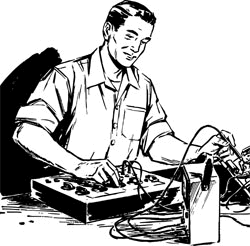Learn about electronics Blog
If you like what you have seen so far from Learn-about-electronics.com subscribe by clicking on the little orange button on the left hand menu. We are continually adding new and interesting content.
NEETS: Learn about electronics and electricity with free tutorials.
NEETS: Learn about electronics and electricity from free online tutorials. Learn how to solder, build cable connections and much more.
Continue reading "NEETS: Learn about electronics and electricity with free tutorials."
Fusion Splices
Fusion Splices: Learn about the process of fusion splicing involving the use of localized heat to melt or fuse the ends of two optical fibers together. Also learn about multifiber splicing.
Fuse Ratings
Fuse Ratings: current, voltage, and time delay ratings of standard, delay, and fast fuse types.
Our-Visitors
Our-Visitors: Read what other visitors to our site have to say. Add your own voice. How? Just click on the "Contact Us" page.
Functional Servo Loops
Functional Servo Loops: Learn how these systems are also classified according to their functions.
Full Wave Rectifiers
Full Wave Rectifiers: the practical, conventional, and complete full wave rectifiers.
Frequency in alternating current
Frequency: The number of complete cycles of alternating current or voltage completed each second is referred to as the "(FREQUENCY)".
Frequency Synthesis
Frequency Synthesis: Learn about how frequency synthesis and audio reproduction devices in communications systems work.
Frequency Selection Considerations
Frequency Selection Considerations: maximum and lowest useable frequency and the optimum working frequency.
Frequency Response
Frequency response: In addition to being classified by function, amplifiers are classified by frequency response.
Frequency Multiplication
Frequency Multiplication: Learn about frequency multiplication and the single sideband transmitter in a communications system.
Frequency Meters
Frequency Meters, vibrating reed frequency meter, and a moving disk frequency meter.
Frequency Band Use
Frequency Band Use: Learn about the nine frequencies that make up communications bandwidth and low and medium frequency applications.
Frequencies and Color
Frequencies and Color: light wavelengths, properties of light, luminous bodies and light and color.
Folded Dipole
Folded Dipole: the use of parasitic elements and various stacking arrangements causes a...
Flutter
Flutter: Learn about the result of non-uniform tape motion caused by variations in tape speed that produces frequency modulation of signals recorded onto magnetic tape.
Floated Gyro Unit
Floated Gyro Unit: Learn about another type of rate gyro (often used in inertial navigation equipment), the floated gyro unit.
Flip-Flops
Flip-flops may be used to store data temporarily, to multiply or divide, to count operations, or to receive and transfer information.
Fixed Capacitors
Fixed Capacitors and variable: A fixed-capacitor is constructed in such manner that it possesses a fixed value of capacitance which cannot be adjusted.
Filter
Filter: Effect of frequency on capacitive and inductive reactance, and the Reaction to circuit by change in frequency,
Field Measurements in Fiber Optics
Field Measurements differ from laboratory measurements because they measure the transmission properties of installed fiber optic components.
Fiberoptic Transmitter Packages
Fiberoptic Transmitter Packages come in various sizes and shapes. The least complex fiber optic transmitters are typically packaged in transistor outline (TO) cans or hybrid microcircuit modules in du
Fiberoptic System Topology
Fiberoptic System Topology: A point-to-point fiber optic data link consists of an optical transmitter, optical fiber, and an optical receiver.
Fiber Optic Transmitters
Fiber Optic Transmitters are hybrid electro optic devices. They convert electrical signals into optical signals and launch the optical signals into an optical fiber.
Fiber Optic Systems
Fiber Optic Systems: Learn about fiber optic systems and some advantages and disadvantages.
Fiber Optic Splices
Fiber Optic Splices: Learn about optical fiber splices and some of their aplications.
Fiber Optic Receivers
Fiber Optic Receivers: In fiber optic communications systems, optical signals that reach fiber optic receivers are generally attenuated and distorted.
Fiber Optic Light
Fiber Optic Light: Learn how fiber optics deals with the transmission of light energy through transparent fibers.
Fiber Optic History
Fiber Optic History: Learn how fiber optics were developed and what was responsible for their invention.
Fiber Optic Couplers
Fiber Optic Couplers: One type of fiber optic component that allows for the redistribution of optical signals is a fiber optic coupler.
Fiber Optic Connectors
Fiber Optic Connectors: Learn about how a fiber optic connector is a demateable device that permits the coupling of optical power between two optical fibers or two groups of fibers.
Fiber Optic Bandwidth and Chromatic Dispersion
Fiber Optic Bandwidth: Learn about bandwidth and dispersion characteristics in optical fiber.
Continue reading "Fiber Optic Bandwidth and Chromatic Dispersion"
Fiber Optic Attenuation
Fiber Optic Attenuation: Attenuation is the loss of optical power as light travels along the fiber.
Fiber Mismatches
Fiber Mismatches: Learn about what occurs when manufacturers fail to maintain optical or structural (geometrical) tolerances.
Fiber Geometry
Fiber Geometry: Learn about measurements used to reduce system attenuation and coupling loss resulting from poor fiber fabrication.
Fiber End Preparation
Fiber End Preparation: Learn how in fiber-to-fiber connections, a source of extrinsic coupling loss is from the result of poor fiber end preparation.
Fiber Alignment
Fiber Alignment: Learn about the main source of extrinsic coupling loss in fiber-to-fiber connections that causes poor fiber alignment.
Fading
Fading: The most troublesome and frustrating problem in receiving radio signals is variations in signal strength, most commonly known as FADING.



























